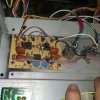 I'm hoping someone could help me out. I have a Tascam 52. I have a paper manual for it however my deck has XLR connectors on the back, No volume pots on the front and my manual doesn't cover the In/Output board.
I'm hoping someone could help me out. I have a Tascam 52. I have a paper manual for it however my deck has XLR connectors on the back, No volume pots on the front and my manual doesn't cover the In/Output board.I picked this deck up from a recording studio and they hacked some things together, one was complete disconnection of the In/output board. This one in particular has a couple of variable pots on it which of course my manual doesn't have either.
So, I'm looking for information, a scanned sheet from the correct manual, or some pics if anybody has anything I would be grateful. I'm afraid the studio has damaged an op amp or replaced something with the wrong thing etc etc. I already repaired one of the channel boards and got the machine working for the most part but what happens now is when I connect the yellow wire (-15vdc) the playback gets muddy to the point of non recognition.
I did get some sheets from Sam but the board is different in a 52 NB or DB apparently.
Last edited:


![IMG_20181129_213013864[1].jpg IMG_20181129_213013864[1].jpg](https://www.tascamforums.com/data/attachments/1/1646-41f817e78c7f2c6be6f4afd74be7644c.jpg)
![IMG_20181129_214716388[1].jpg IMG_20181129_214716388[1].jpg](https://www.tascamforums.com/data/attachments/1/1647-8034dab7ea5f17275db46f7291ef4ed0.jpg)

